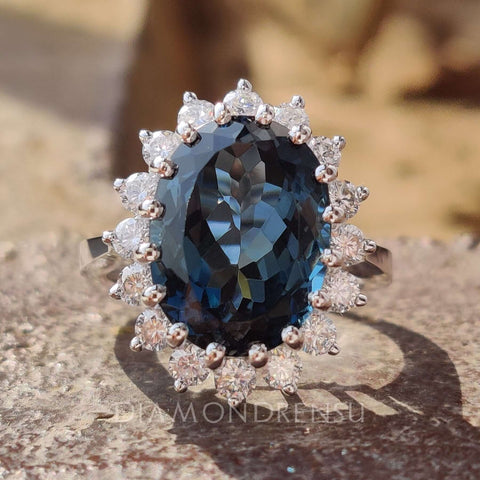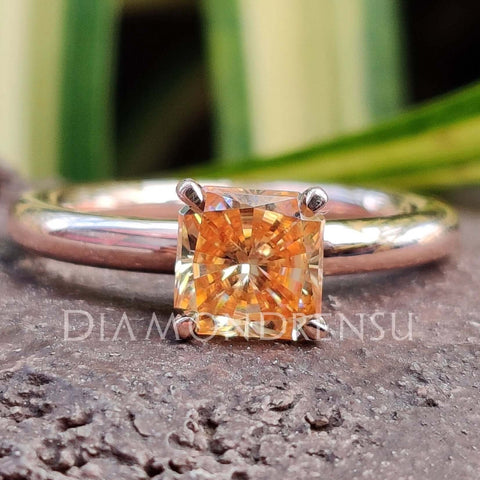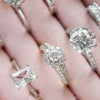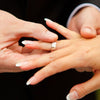
Wedding Ring on Right Hand: Cultural Significance and Meanings
The tradition of wearing a wedding ring on the left hand is widely recognized in many Western cultures. However, you might be surprised to learn that in some parts of the world, including certain Eastern European countries and Western Asia, it is customary to wear the wedding ring on the right hand. This practice is not just a matter of preference, but often has deep cultural and religious significance.
Dazzling Wedding rings, Brilliant Deals – Shop Today!
The meaning of the ring’s placement can vary markedly between cultures. While in some instances the right hand is used to signify the wearer is married, in others, specific meanings are attached to the right hand as symbolizing the strength and authority of the union, or religious reasons may dictate the practice. For example, in Orthodox Christian ceremonies, rings are often placed on the right hand to symbolize the "right hand of God," an integral aspect of the faith.
The decision to wear the wedding ring on the right hand may reflect personal or familial beliefs, societal norms, or simply personal comfort. While the left hand is often associated with engagement and marriage due to ancient beliefs about the "vena amoris" or vein of love leading directly to the heart, the choice of which hand to adorn with a wedding ring ultimately comes down to personal and cultural preference, and there is no single way that is inherently correct.
Historical Significance of Wedding Rings
Wedding rings symbolize commitment and love, with roots that stretch back to ancient civilizations. Your understanding of these symbols deepens when exploring their origins and historical journey.
Origins in Ancient Egypt
Ancient Egypt is where the tradition of exchanging rings as a sign of love and eternity first emerged. Egyptians saw the circle as a powerful symbol, representing endlessness and the rings were fashioned from materials like reeds and leather. The placement of the ring on the ring finger was significant due to a belief in the "vena amoris", a vein thought to run directly from this finger to the heart.
Shop Our Best Seller Wedding Rings
Adoption by Romans
Following this tradition, the Ancient Romans began to use rings in betrothal ceremonies and as a public pledge of marriage. Unlike Egyptians, who often used materials that were not durable, Romans preferred iron and other metals symbolizing strength and permanence. These betrothal rings, worn on the left hand, indicated the man's holding of the woman's hand in marriage, though the exact hand may have differed over time and place within Ancient Rome.
Cultural Variations and Traditions

In exploring the traditions surrounding wedding rings, you'll discover that the custom of wearing a wedding ring on the right hand is prevalent in many cultures. This practice is particularly common in Eastern Europe and among Orthodox Christians, highlighting how cultural influences shape marital symbolism.
Right Hand Wedding Rings in Eastern Europe
In the countries of Eastern Europe such as Russia, Ukraine, and Poland, it is customary for the wedding ring to adorn the right hand. The reason behind this tradition is deeply rooted in the customs and religious beliefs of the region. For many Eastern European cultures, the right hand represents the path of virtue and justice, making it a fitting location for a symbol of marital fidelity.
Orthodox Christian Practices
Orthodox Christian traditions, particularly in countries like Greece and Russia, dictate the wearing of wedding rings on the right hand. This practice embodies the religious doctrine that the right hand represents honor and authority. Orthodox Christians in these regions may reference scriptural texts that favor the right hand as a sign of righteousness and this symbolism extends to the sanctity of marriage vows.
Wedding Ring Customs Worldwide
While you may be accustomed to seeing wedding rings on the left hand in many Western cultures, such practices are not universal. Across the globe, the significance and placement of wedding rings vary, reflecting a rich tapestry of cultural beliefs and customs. Whether honoring ancient heritage or religious values, these marital tokens are as diverse as the societies from which they emerge, with the right hand serving as the vessel for this promise in numerous cultures.
Symbolism and Meaning
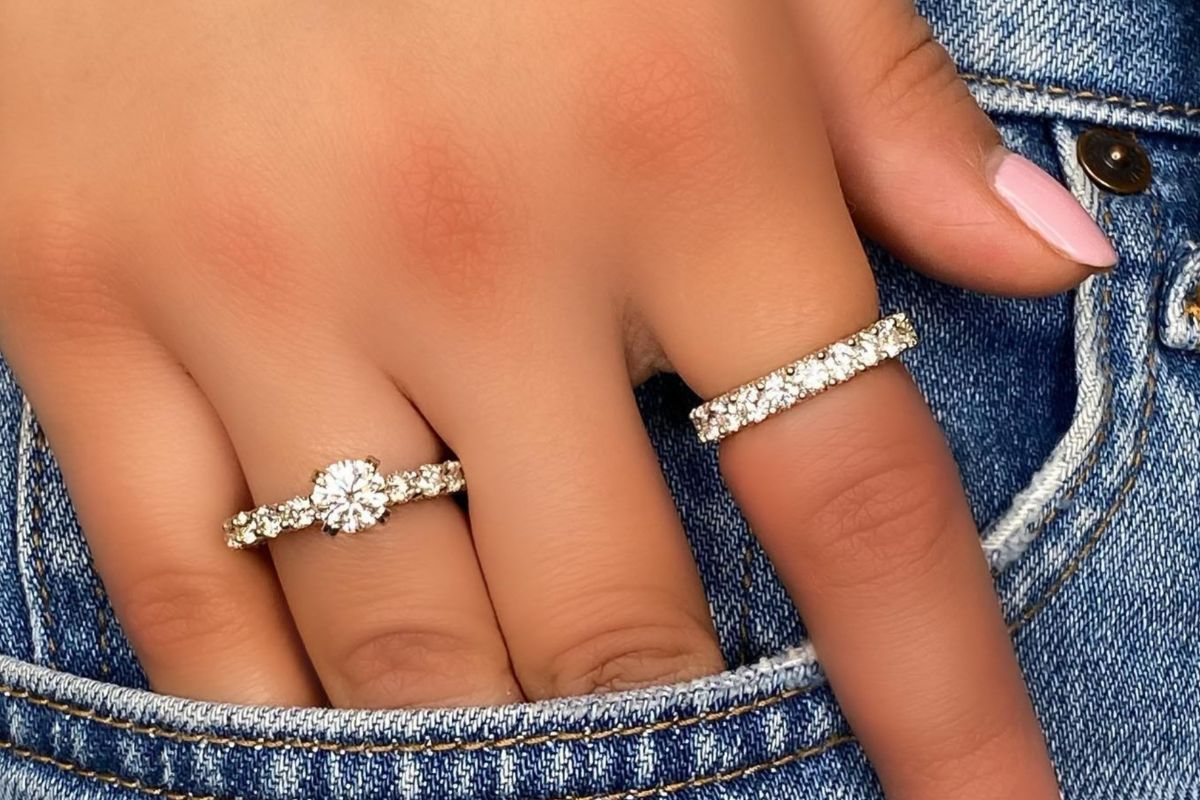
When you look at a wedding ring on the right hand, you're observing a rich tapestry of symbolism and meaning that transcends cultures and history, with particular attention paid to the "Vena Amoris" and the shape of the ring as a circle.
Vena Amoris: The Vein of Love
Historically, it was believed that a vein ran directly from the fourth finger of the left hand to the heart, named the Vena Amoris, or "vein of love". This belief contributed to the tradition of wearing the wedding ring on that specific finger as a symbol of eternal love and commitment. However, in some cultures and traditions, you may observe the wedding ring worn on the right hand, which may carry similar symbolic significance or represent cultural heritage.
The Circle as a Symbol of Eternity
A wedding ring's circular shape holds universal symbolism as it symbolizes eternity. With no beginning and no end, the circle is a potent symbol of never-ending love and fidelity. The continuous loop reminds you of the ongoing commitment and the journey of marriage that you embark upon with your partner. This symbolism is widely recognized and cherished across different societies and forms the foundation of the sacred marital bond.
Anatomical and Practical Considerations
When considering which hand to adorn with a wedding ring, you should take into account both anatomical factors and practical daily use. Personal preference plays a role, but there are distinct differences between left and right-handed people that can influence this choice.
Differences Between Left and Right-Handed People
Left-handedness affects approximately 10% of the population. If you're left-handed, your dominant hand is your left one. This can mean your left hand is more active and potentially more prone to damage or injury if you wear rings on it. This is because your dominant hand typically engages in more complex and forceful activities.
On the other hand, if you're right-handed, as the majority are, you'd experience similar concerns for your right hand. As rings can interfere with fine motor tasks, wearing a wedding ring on the less active hand, which for most is the left hand, might be more practical.
Dominant Hand and Ring Wearing Preferences
Your dominant hand can also influence your ring wearing preference due to practicality. For instance, if you are left-handed and involved in tasks that could potentially damage your ring, you might opt to wear it on your right hand to reduce the risk of scratching or deforming it.
Moreover, some cultures link the left hand directly to the heart, which is why a wedding ring is traditionally worn on the left ring finger. However, your personal preference might lead you to wear your ring on the right hand instead, especially if it feels more comfortable or if you want to protect the ring during daily tasks.
Contemporary Perspectives on Ring Placement
| Perspective | Description |
|---|---|
| Traditional Placement | Engagement rings are worn on the ring finger of the left hand, and wedding bands are added during the ceremony. |
| Modern Stacking | Some individuals choose to stack their engagement ring and wedding band on the same finger for a fashionable and cohesive look. |
| Right Hand Trend | Wearing rings on the right hand, whether engagement or wedding, has become more popular for a unique and contemporary appearance. |
| Separate Hands | Engagement and wedding rings are worn on separate hands or fingers to showcase each ring individually. |
| Mixing Metals | Couples opt for mixing metals between engagement and wedding rings or experimenting with unconventional materials for a modern twist. |
| Unique Finger Choices | Some individuals choose non-traditional fingers, such as the middle or index finger, for a distinct and personal touch. |
| Personalized Arrangements | Couples have the freedom to create personalized arrangements that reflect their style, values, and cultural influences. |
| Temporary Ring Placement | Some opt for temporary placement during specific activities, like moving the ring to a necklace during exercise or work. |
| Symbolic Meaning | Rings may be worn on specific fingers to symbolize particular milestones or achievements within the relationship. |
| Fluid Traditions | Contemporary perspectives embrace the fluidity of ring placement, allowing couples to express their unique stories and preferences. |
The choice of which hand to wear a wedding ring on is influenced by various factors including your personal beliefs, fashion trends, and the type of commitment the ring symbolizes.
Personal Preference and Significance
Your personal preference plays a major role in the decision to wear a wedding ring on the right hand. This practice may reflect your individual values, cultural background, or a desire for independence. Some see the right hand ring as a symbol of their professional accomplishments or personal milestones, distinguishing it from the traditional marital symbolism of the left hand.
- Values: Your choice might align with your cultural values or personal beliefs about partnership and identity.
- Personality: Wearing a ring on the right hand might resonate with your unique personality traits, affirming a sense of self.
Fashion and Style Influences
Fashion trends can also dictate ring placement. The right hand is often seen as the stage for stylistic expression, allowing you to showcase your sense of fashion and complement your attire.
- Trends: Current style trends might encourage wearing statement pieces, like large or ornate rings, on the right hand.
- Complementing Attire: You might choose rings that coordinate with your clothing, making a fashion statement.
Promises and Pledges Beyond Marriage
Rings on the right hand often represent promises and pledges beyond traditional marriage. Promise rings, for instance, symbolize a variety of commitments that might not be related to nuptial agreements.
- Promise Rings: These can signify pre-engagement, friendship, or personal goals and are usually worn on the right hand to indicate their distinct nature from engagement or wedding rings.
- Intent: The intent behind wearing a ring on the right hand could be to signal commitment to something personal or professional, rather than a romantic partnership.
Jewelry Design and Materials
In the realm of wedding and engagement rings, the choices in materials and designs play a significant role in both aesthetics and symbolism. Below, you'll explore the specifics of metals and gemstones used, as well as how ring designs have evolved over time to reflect personal taste and cultural significance.
Types of Metals Used
Gold, a classic choice for wedding bands, comes in various hues such as yellow, white, and rose, each created by alloying gold with different metals. For example, white gold is often combined with nickel or palladium to achieve its color and increase its strength. Then there's platinum, which stands out for its durability and natural silvery-white sheen. It's denser and more hardwearing than gold, making it an excellent choice for wedding bands that last a lifetime. And let's not forget silver, an affordable yet stylish metal, although it tarnishes and is softer, requiring more care.
- Gold: Traditional, malleable, comes in yellow, white, and rose
- Platinum: Durable, heavy, naturally white
- Silver: Affordable, requires maintenance for tarnish
Gemstones and Their Meanings
Gemstones add a personal touch and a splash of color to your wedding or engagement ring. The most iconic of these is the diamond, not only because of its captivating brilliance but also because it symbolizes everlasting commitment, thanks to its unmatched hardness. The GIA (Gemological Institute of America) grading system ensures the quality and authenticity of diamonds based on characteristics like cut, color, clarity, and carat weight. Other gemstones like sapphires, which represent sincerity and faithfulness, or rubies, symbolizing passion, are also popular choices, each bringing its own unique meaning and beauty to the design.
- Diamond: Symbolizes durability and commitment; graded by GIA
- Sapphires: Blue color represents sincerity, durability next to diamonds
- Rubies: Red hue for passion; durable but requires proper care
Ring Design Evolution
Over the years, ring designs have witnessed significant change, influenced by cultural shifts, fashion trends, and advancements in craftsmanship. The traditional solitaire diamond ring remains a timeless choice for many, but contemporary designs often blend old and new elements, like incorporating vintage motifs into modern, streamlined shapes. The engagement ring sometimes features complementary designs that fit seamlessly with the wedding band, creating a cohesive set. Customization has also become a key aspect, with couples opting to incorporate unique elements that reflect their personal journey and style.
- Classic Solitaire: Single diamond, timeless elegance
- Contemporary Blends: Fusion of vintage and modern styles
- Customization: Personalized features for unique significance
Choosing the Right Wedding Ring
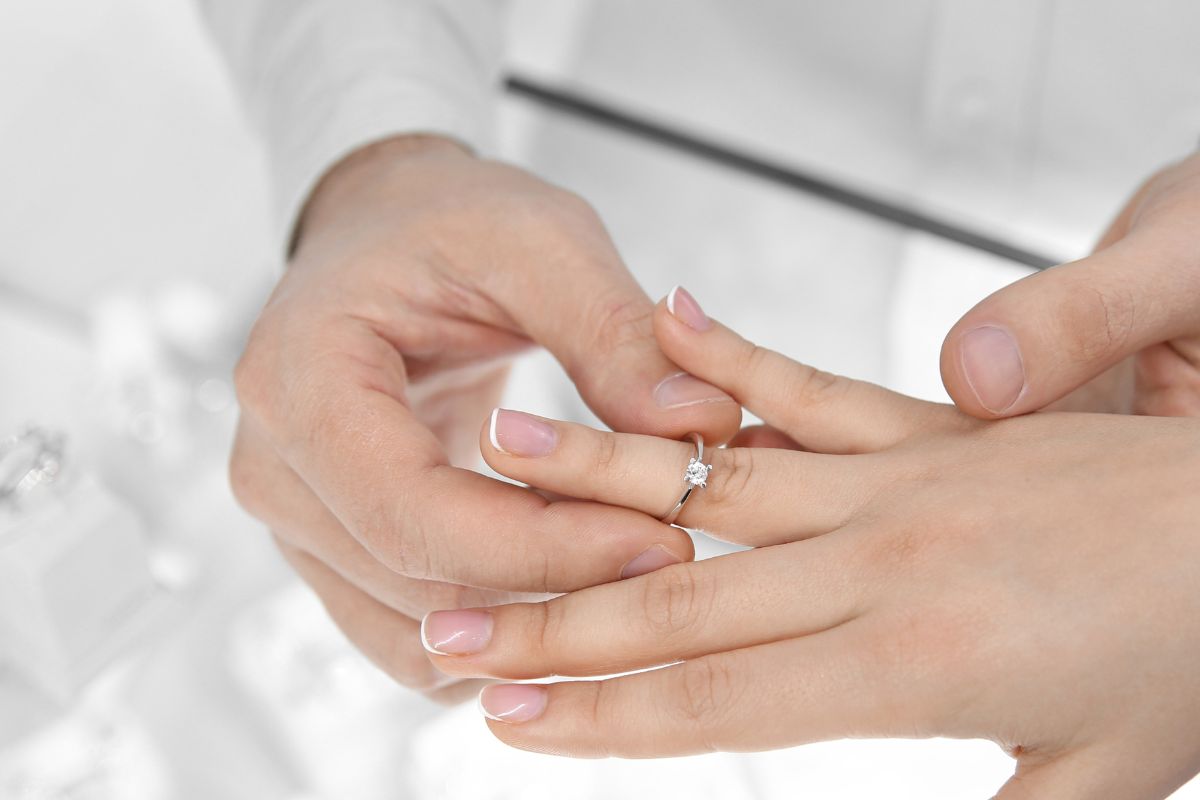
When selecting a wedding ring to wear on your right hand, you must carefully consider various factors that reflect your personal taste, cultural significance, and the overall symbolism of commitment and partnership.
Factors Influencing Selection
Your personal preference dictates the style, metal, and design of your wedding ring. Beyond aesthetics, your ring should align with your values and what you want it to represent in your life. Cultural norms may also influence your choice; in some cultures, for instance, wearing a wedding ring on the right hand is a traditional practice that you may wish to honor.
- Material: Choose from gold, platinum, or alternative metals.
- Design: Consider classic bands, intricate engravings, or decorative accents.
- Symbolism: Think about the ring's representation of partnership or commitment.
If fashion is important to you, current trends might sway your selection while ensuring the ring complements your daily wardrobe.
Consulting with Experts
For peace of mind, you might consult with experts from institutions like the Gemological Institute of America (GIA) to ensure the quality of precious stones or to understand the intricacies of ring craftsmanship. These experts can guide your understanding of:
- Diamond Quality: Using the four Cs- color, clarity, cut, and carat weight.
- Craftsmanship: Learning about the hallmarks of well-crafted jewelry.
Wedding Rings as a Statement of Individuality
Choosing a ring for your right hand can be a profound statement of individuality. This choice lets you showcase your unique personality and style, differentiating from the traditional left-hand ring. Your right-hand ring speaks to the world about who you are and the uniqueness of your partnership.
- Unconventional Choices: Bold designs or unusual materials.
- Meaningful Additions: Engravings or custom features that tell a personal story.
Remember, the right wedding ring for you is the one that resonates with your personal narrative and the life you are building with your partner.
Ring Wearing Etiquette
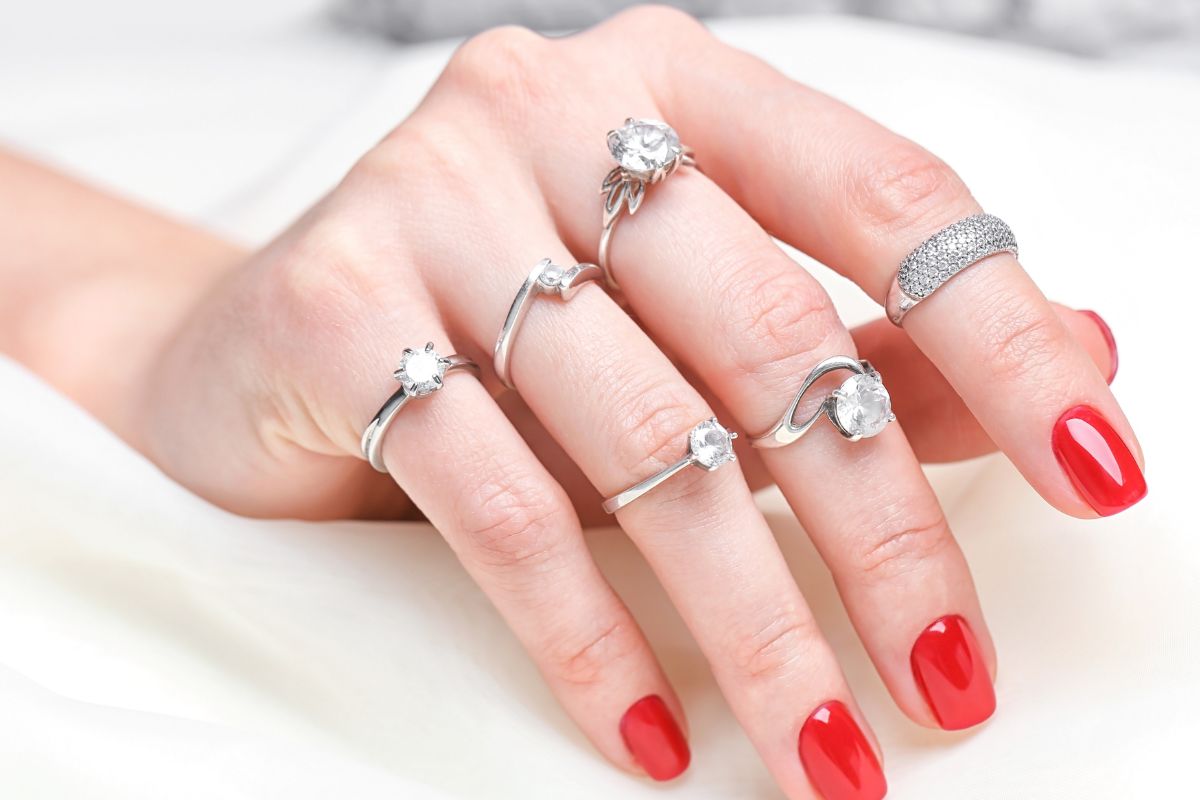
When it comes to wedding rings, placement matters just as much as the design. The hand and finger on which you wear your ring communicate specific messages about your commitment and marital status.
Proper Placement and Meaning
Wearing a wedding ring on the ring finger of your right hand is a practice steeped in symbolism and history. Traditionally, the fourth finger of the left hand has been the common choice owing to the belief that it contains the 'vena amoris' or 'vein of love' leading directly to the heart. However, in several European and some South American cultures, the wedding ring is worn on the right hand.
- Left Hand: U.S., Canada, U.K., France, Italy
- Right Hand: Germany, Russia, India, Spain
Cultural Etiquette and Expectations
Observing cultural norms around wedding ring placement ensures respect for traditional values. For example, Orthodox Christians in Eastern European countries often wear wedding rings on the right hand as a part of their religious and cultural practice. Meanwhile, in Western cultures, the left hand is more commonly associated with wedding ceremonies and marital commitment.
- Orthodox Christians: Right hand
- Western Cultures: Left hand
Adapting Traditions in Modern Ceremonies
Modern ceremonies are increasingly adaptive, with couples personalizing their wedding to reflect individual tastes. This might involve wearing a wedding ring on the right hand by choice or when expressing personal or familial association. Regardless of the hand chosen, the intent remains to signify commitment and unity within the bounds of marriage. In a church, during the ceremony, or at any given moment, what matters most is the promise that the ring symbolizes, not merely the custom.
- Adaptation: Personal choice or familial ties
- Symbolism: Commitment and unity
Global Interpretations of Ring Wearing
| Culture/Region | Ring Wearing Tradition |
|---|---|
| Western Countries | Engagement rings are typically worn on the left ring finger. Wedding bands are added during the ceremony. Right hand wearing is also common. |
| Eastern Countries | Engagement and wedding rings are often worn on the ring finger of the right hand. Some cultures have specific traditions regarding the finger and hand used. |
| India | Traditionally, wedding rings are worn on the third finger of the left hand. Toe rings are also significant, representing marital status. |
| Middle East | Engagement and wedding rings are commonly worn on the right hand. Rings with cultural or religious significance are prevalent. |
| China | Wedding rings are often worn on the ring finger of the left hand. Jade and other traditional materials are also popular for rings. |
| Japan | Wedding rings are worn on the fourth finger of the left hand. Some couples also exchange "friendship rings" before marriage. |
| Africa | Ring wearing traditions vary widely among African cultures. Rings may signify status, affiliation, or mark important life events. |
| Latin America | Engagement and wedding rings are typically worn on the right hand. Cultural variations exist, and pre-engagement promise rings are also popular. |
| Native American Cultures | Traditional jewelry, including rings, holds cultural significance and varies among tribes, often representing spirituality and heritage. |
| Global Modern Trends | Increasingly, individuals around the world adopt personalized ring wearing traditions, mixing cultural influences and expressing individuality. |
When you consider the practice of wearing wedding rings, it's important to recognize that customs vary widely around the world. You'll find that interpretations not only differ from country to country but also between religious and secular perspectives.
United States Versus International Practices
In the United States, the tradition is for individuals to wear their wedding rings on their left hand. However, in many other countries, the ring finds its home on the right hand. Russia, Germany, and Ukraine are examples of countries where you might observe wedding rings prominently displayed on the right. In Spain and Colombia, the practice also leans towards the right hand for indicating one's married status. The variations in traditions are reflective of a tapestry of cultural traditions that stretch back through history.
Religious and Secular Views
Religious customs can influence where a wedding ring is worn. For instance, in Orthodox Christian countries like Greece and Bulgaria, wedding rings are typically worn on the right hand, which aligns with religious symbolism. The right hand is thought to be the hand of power and moral rectitude. On the other hand (no pun intended), Western Christian practices, including prevalent customs in the United States and the UK, often feature the ring on the left hand. In Jewish tradition, during the wedding ceremony, the ring is placed on the index finger of the right hand, although it's commonly worn on the left hand post-ceremony. Denmark offers an interesting case where your engagement ring goes on your left hand, and then it moves to your right hand when you're married.
These practices are deeply embedded in the fabric of each culture and can be reflective of both historical origins and contemporary influences.
The Future of Wedding Ring Traditions
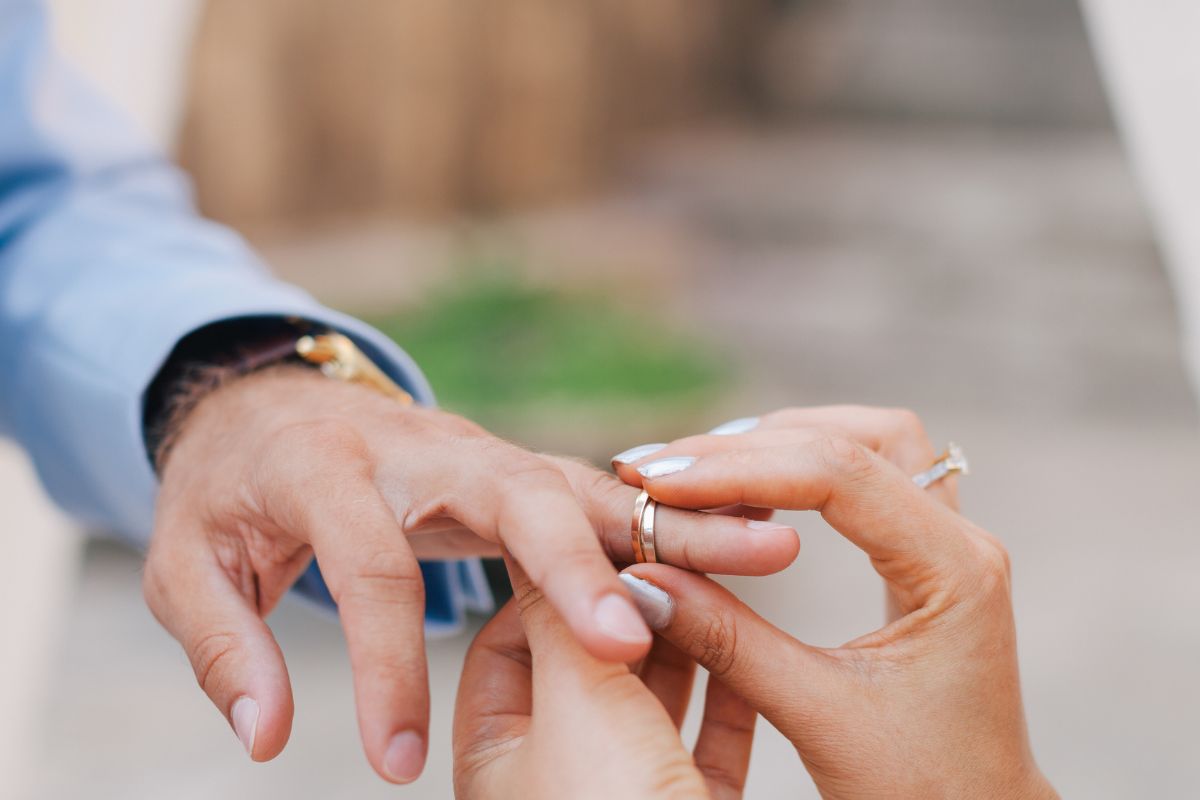
In exploring the future of wedding ring traditions, you'll discover how evolving beliefs and the adaptability of symbols are reshaping this enduring practice.
Evolving Views on Marriage and Partnership
Your understanding of marriage and partnership is undergoing a significant transformation. Shifting cultural values and a growing appreciation for independence play key roles in this evolution. Rings, once a traditional symbol of union, may take on varied designs and meanings, reflecting personal rather than collective ethos. These changes will likely see couples seeking rings that symbolize their unique narratives, potentially diverging from the customary placement on the left hand to more modern expressions of commitment.
Adaptability and Change in Ring Symbols
Traditions are not static; they evolve as you adapt to new perspectives and societal norms. The wedding ring, once a universal symbol of matrimony, is poised for significant change as you look to the future. For instance, the concept of a male engagement ring has highlighted the potential for adaptability in what these symbols represent. It's conceivable that future rings will serve as mementos that embody personal values rather than simply mark marital status. They may be worn differently, inscribed with unique elements, or eschewed entirely for new forms of expression. As you move forward, the symbols you choose to portray your commitments might look quite unlike those your ancestors recognized.
Conclusion
In various cultures, the placement of your wedding ring on the right hand instead of the left is more than a simple matter of preference; it often reflects deep cultural and symbolic meanings. Traditionally, in many Western societies, the wedding ring is worn on the left hand. Yet, in some countries such as Germany, Russia, and India, the right hand is the chosen finger for the symbol of marital commitment.
The switch to the right hand can signify specific societal norms or personal beliefs. For instance, in Orthodox Christianity, the right hand is considered the hand of honor and strength, aligning with positive cultural significances and deep commitments.
- Tradition: The hand you wear your ring on can have traditional roots.
- Culture: Cultural practices often dictate the norms regarding this practice.
- Meaning: Symbolism varies with the side of the hand on which the ring is worn.
Behind this choice lies a rich tapestry of history and significance that might influence your decision. While traditions provide a compass, your personal connection to these customs should guide you. The hand that bears the wedding ring ultimately contributes to the mosaic of matrimonial traditions and meanings, each reflective of the commitment symbolized by the ring itself. Remember that the decision is yours and is as unique as your union. Whether you choose the right or left, it is the promise the ring represents that truly matters.
Frequently Asked Questions
Navigating the traditions around wedding rings can be complex, but understanding the customs of wearing them on the right hand sheds light on cultural practices and personal choices.
In which cultures is it customary for individuals to wear a wedding ring on their right hand?
In some Eastern European and South American cultures, wearing a wedding ring on the right hand is the norm. This includes countries like Russia, Poland, Greece, and Colombia, where the right hand symbolizes the oath taken during the wedding ceremony.
What is the significance behind men wearing wedding rings on their right hand?
For men, wearing a wedding ring on the right hand can reflect personal preference or cultural background. In some societies, men wear their wedding bands on the right to distinguish from the women's rings on the left, or it may simply be more comfortable for those who are left-handed.
Can wearing a wedding ring on the right hand indicate marital separation?
While less common, some individuals choose to wear their wedding ring on the right hand as a symbol of separation or divorce. However, this practice is highly personal and not widely recognised as a standard signal of marital status.
What does it represent when a widow transfers her wedding ring to her right hand?
When a widow transfers her wedding ring to her right hand, it often signifies continued love and honor for her deceased spouse while acknowledging her change in marital status. This gesture is a personal choice and varies from person to person.
Is it acceptable for left-handed individuals to wear their wedding rings on their right hand?
Left-handed individuals may opt to wear their wedding ring on the right hand for practical reasons, such as avoiding damage to the ring during daily tasks. Comfort and the reduction of wear and tear on the ring are often the primary considerations.
On which hand should an unmarried woman wear a ring, and what does it signify?
An unmarried woman can wear a ring on any finger of her right hand, and it usually does not signify marital status. Rings on the right hand can often be expressive pieces or statement jewelry without any specific cultural significance attached to them.
Checkout some of our top collections:
Leave a comment
Please note, comments must be approved before they are published.










